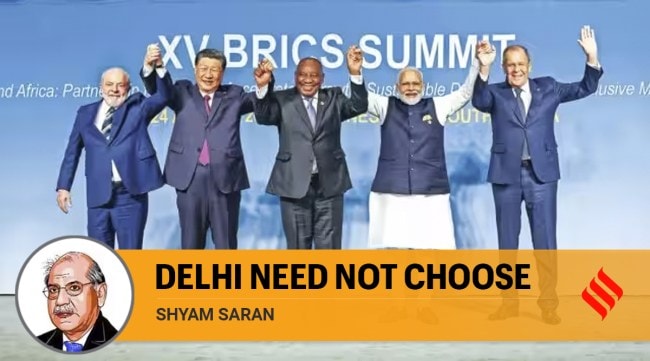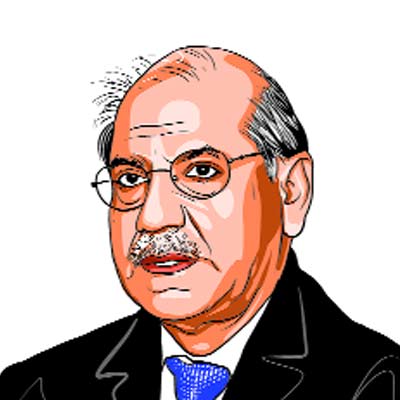Opinion Shyam Saran writes: BRICS is growing – and that doesn’t hurt India’s interests
An expanded BRICS will not hurt India’s interests. It must engage with all — BRICS, SCO, Quad and G7
 In the 15 years of its existence, BRICS’ key achievement has been the BRICS New Development Bank (NDB).
In the 15 years of its existence, BRICS’ key achievement has been the BRICS New Development Bank (NDB). The recent BRICS summit in Johannesburg, South Africa, which witnessed more than a doubling of its original membership of five major emerging economies, has led to exaggerated expectations of the grouping’s rising influence on the global economy and on the restructuring of global governance regimes. The grouping was established in 2009 with Brazil, Russia, India and China as members. South Africa joined a year later. At the initiative of China, supported by Russia, six new members — Argentina, Egypt, Ethiopia, Iran, Saudi Arabia and the UAE — have been inducted. Several other developing countries have reportedly conveyed their interest in joining the group and there could be more rounds of expansion. Earlier there were indications that India and Brazil were not enthusiastic about an expansion. Neither would have wanted BRICS to become a blatantly anti-Western platform. India would additionally have had reservations about an expanded membership adding further clout to an already dominant China. However, it appears that the choice of new members is the result of political compromise rather than the application of any agreed criteria. The new members, with the exception of Iran, have significant stakes in their relationship with the West. Therefore, China has not succeeded in transforming BRICS into an anti-West lobby.
Why have so many countries of the Global South shown such unusual interest in BRICS? The answer lies in their desire to hedge in an increasingly uncertain world with shifting political and security equations. There is widespread anxiety about their vulnerability to US sanctions of the kind that froze a significant part of Russia’s foreign exchange reserves. There may also be an expectation of the Chinese leading a shift to an alternative global currency. This is unlikely to happen for some time as global financial and currency markets are still dominated by the US dollar and may remain so for the foreseeable future. In the meantime, promotion of trade in local currencies and the raising of funds through local currency bonds, which BRICS has been promoting, are a modest and useful beginning. In the 15 years of its existence, BRICS’ key achievement has been the BRICS New Development Bank (NDB), which has become a modest source of development finance for developing countries. Its current loan portfolio totals $ 90 billion. But its business is conducted in US dollars, even though diversifying away from the dominant US currency is a stated objective of the grouping. BRICS has set up a contingency reserve which may be drawn upon by a member who may be facing balance of payments problems. It has not been used so far. There has been more recent progress in promoting the use of local currencies for trade settlement, but the talk of creating an alternative BRICS currency rivalling the US dollar has remained just that — talk.
The interest in BRICS also reflects a growing frustration among developing countries that their interests and aspirations continue to be ignored by the developed countries. International institutions like the UN and multilateral financial institutions such as the IMF and the World Bank continue to be dominated by the G7. As the economic and security profile of the major emerging economies continues to expand, there is a more insistent demand for a greater voice in global governance. These are sentiments that India can relate to and therefore its membership of and active participation in an expanded BRICS will continue to be of value. China will be influential in the grouping but the presence of additional middle powers which are exercising greater agency than in the past, would balance China’s role.
The role of BRICS will expand as the economic, technological and military capabilities of its members continue to increase and narrow the gap with the G7 advanced countries. India’s successful Chandrayan mission coinciding with the BRICS summit underscored the fact that this was a grouping of substantial powers, not like the gathering of the weak that was characteristic of the Non-Aligned Movement during the Cold War. The expanded membership will make BRICS an energy superpower, with Saudi Arabia, Iran and Russia dominating the global energy market. But unlike the G7, BRICS lacks a broad ideological affinity and coherence. The G7 has also matured over half a century since its birth in the wake of the oil crisis and resultant high inflation in 1973. BRICS has a history of only 15 years. Furthermore, while in terms of GDP, trade and investment volumes, BRICS has caught up with the G7, its members have sharper internal contestations. The India-China rivalry is an example. The G7 are also a tightly knit security grouping. All its members are also members of NATO and Japan is a US treaty ally. The BRICS countries do not have a common security perspective.
There is apprehension in the West that BRICS is determined to undermine the international order set in place by the West in its phase of ascendancy. The reality is that it is the Western countries themselves who have been systematically eroding and flouting the rules and norms of this order. This includes the steady marginalisation of the UN, the adoption of blatantly protectionist trade measures and a selfish attempt to shift the energy transition to more sustainable growth onto the developing countries. There is selective application of the tenets of the “liberal international order” and this is no longer acceptable to the increasingly powerful emerging countries. There is no alternative to the G7 engaging with the emerging powers to fashion a new set of mutually acceptable rules of the game. It is more likely that this new architecture of international governance will be fashioned in forums such as the G20, where both advanced and major emerging economies are represented, rather than be spearheaded by BRICS or the G7.
For India, a policy of participating in multiple groupings, which helps address its now multi-faceted interests and aspirations, has proved to be a sound one. An expanded BRICS need not detract from India’s interests and it does not need to choose between BRICS, the Shanghai Cooperation Organisation, the Quad and regular engagement with the G7 as has now become the practice over several years. These expand India’s diplomatic options and help in smoothing the rough edges of an increasingly polarised world.
The writer is a former Foreign Secretary and Honorary Fellow, CPR




